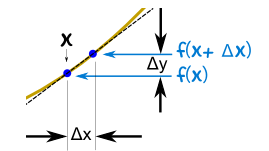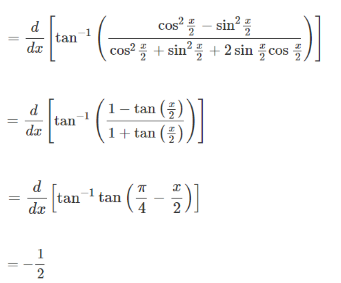Consider a function which involves the change in velocity of a vehicle moving from one point to another. The change in velocity is certainly dependent on the speed and direction in which the vehicle is travelling. If the acceleration is to be calculated, then the limits of the function are essential. The theory of derivative is derived from limits. This article deals with the concept of derivatives, along with a few solved derivative examples.
Derivative Definition
A function which denotes the rate of change of the other function can be called the derivative of that function. The method of finding a derivative can be called differentiation. It is represented as a dependent variable in terms of an independent variable through an equation. The derivative is a value which changes with respect to its input. A derivative is denoted as f’(x).
Derivative Formula
The change in the slope of a function can be termed a derivative. It is represented as follows:

Related topics
Derivative Rules
Below are some important rules used to solve derivative problems.
Constant rule:
Power rule:
Constant multiple rule:
Sum and difference rule:
Product rule:
Quotient rule:
Some Basic Derivatives
Examples on Derivative for IIT JEE
Example 1: Find the derivative of x6+x3+2.
Solution:
Using the power rule (d/dx)x6 = 6x5
(d/dx)x3 = 3x2
(d/dx)2 = 0
Hence, the derivative of x6+x3+2 = 6x5+3x2
Example 2: Solve
Solution:

Example 3: What is the differential coefficient of ax + log x . sinx?
Solution:
Let y = ax + log x . sinx
Differentiating w.r.t. x, we get
dy / dx = ax loge(a) + (1 / x) sin x + log x . cos x
Example 4: If f(x) = logx (logx), then f′(x) at x = e is _____.
Solution:
f(x) = logx (logx)
= log (log x) / logx
f′(x)= 1 / x − 1 / x log (logx) / (logx)2
⇒ f′(e) = [1 / e − 0] / 1
= 1 / e
Example 5: What is the local maximum value of the function log x / x?
Solution:
Let f(x) = log x / x
⇒f′(x) = 1 / x2 − log x / x2
For maximum or minimum value of f (x), find f′(x) = 0
f′(x) = 1 − logex / x2 = 0 or 1− logex / x2 = 0
∴ logex = 1
or x = e, which lies in (0,∞).
For x = e,
d2y / dx2 =−1 / e3, which is −ve.
Hence, y is maximum at x = e, and its maximum value = loge / e = 1 / e.
Example 6: If f(2) = 4, f′(2) = 1 then what is the value of limx→2 x f(2) − 2 f(x) / x−2?
Solution:
Given f(2) = 4, f′(2) = 1
limx→2 x f(2) − 2 f(x) / (x−2) = limx→2 x f(2) − 2 f(2) + 2 f(2) − 2 f(x) / (x−2)
[limx→2 (x−2) f(2) / (x − 2)] − [limx→2 2 f(x) − 2 f(2) / (x−2)]f(2) − 2 limx→2 f(x) − f(2) / [x−2] = f(2) − 2 f′(2)
= 4− 2(1)
= 4−2
= 2
Example 7: In the mean-value theorem f(b) − f(a) / b−a = f′(c), if a = 0, b = 1 / 2 and f(x) = x (x−1) (x−2) , then what is the value of c?
Solution:
From the mean value theorem, f′(c)= f(b) − f(a) / b−a
Given that a=0, f(a)=0 and b = 1 / 2, f(b) = 3 / 8
f′(x) = (x−1) (x−2) + x (x−2) + x (x−1)
f′(c) = (c−1) (c−2) + c (c−2) + c (c−1)
= c2 − 3c +2 + c2 − 2c + c2 − c
f′(c) = 3c2 −6c + 2
According to the mean value theorem,
f′(c)= f(b) − f(a) / b−a
3c2 − 6c + 2= (3/8)−0 / (1/2) − 0 = 3 / 4
3c2 − 6c + 5 / 4 = 0
On solving the above equation, the value of c obtained is
c = 6 ± √[36−15] / 2 × 3
= [6 ± √21] / 6
c = [1 ± √21] / 6
Recommended Videos
Methods of Differentiation – JEE Solved Questions

Important Theorems of Differentiation for JEE

Frequently Asked Questions
Give the quotient rule of derivatives.
If u and v are two functions, then (d/dx)(u/v) = [v(du/dx) – u (dv/dx)]/v2.
What is the derivative of a constant function?
The derivative of a constant function is 0.
What is the derivative of ax?
The derivative of ax is ax log a.

Comments